Quarks Don’t Actually Have Colors
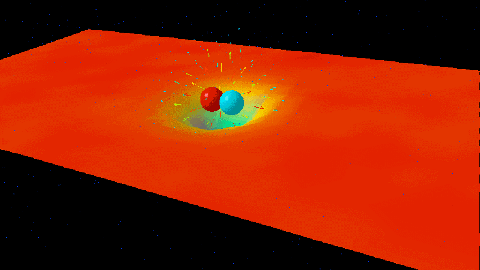
Red, green, and blue? What we call ‘color charge’ is far more interesting than that.
At a fundamental level, reality is determined by only two properties of our Universe: the quanta that make up everything that exists and the interactions that take place between them. While the rules that govern all of this might appear complicated, the concept is extremely straightforward. The Universe is made up of discrete bits of energy that are bound up into quantum particles with specific properties, and those particles interact with one another according to the laws of physics that underlie our reality.
Some of these quantum properties govern whether and how a particle will interact under a certain force. Everything has energy, and therefore everything experiences gravity. Only the particles with the right kinds of charges experience the other forces, however, as those charges are necessary for couplings to occur. In the case of the strong nuclear force, particles need a color charge to interact. Only, quarks don’t actually have colors. Here’s what’s going on instead.
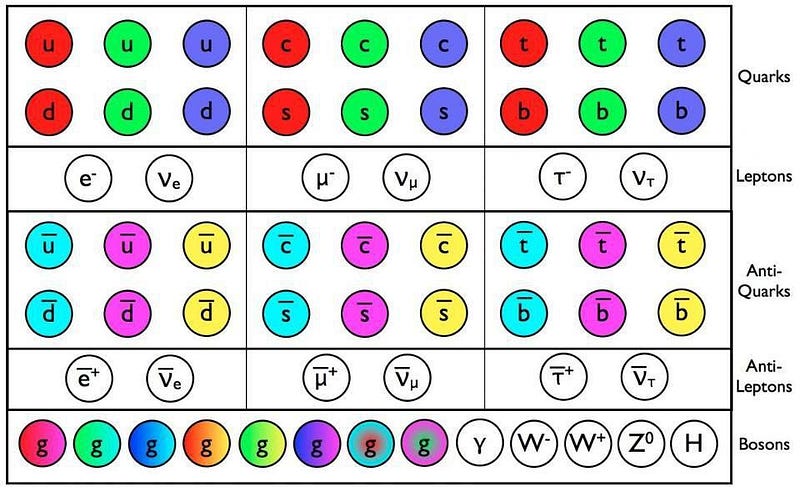
While we might not understand everything about this reality, we have uncovered all the particles of the Standard Model and the nature of the four fundamental forces — gravity, electromagnetism, the weak nuclear force, and the strong nuclear force — that govern their interactions. But not every particle experiences every interaction; you need the right type of charge for that.
Of the four fundamental forces, every particle has an energy inherent to it, even massless particles like photons. So long as you have energy, you experience the gravitational force. Moreover, there’s only one type of gravitational charge: positive energy (or mass). For this reason, the gravitational force is always attractive, and occurs between everything that exists in the Universe.
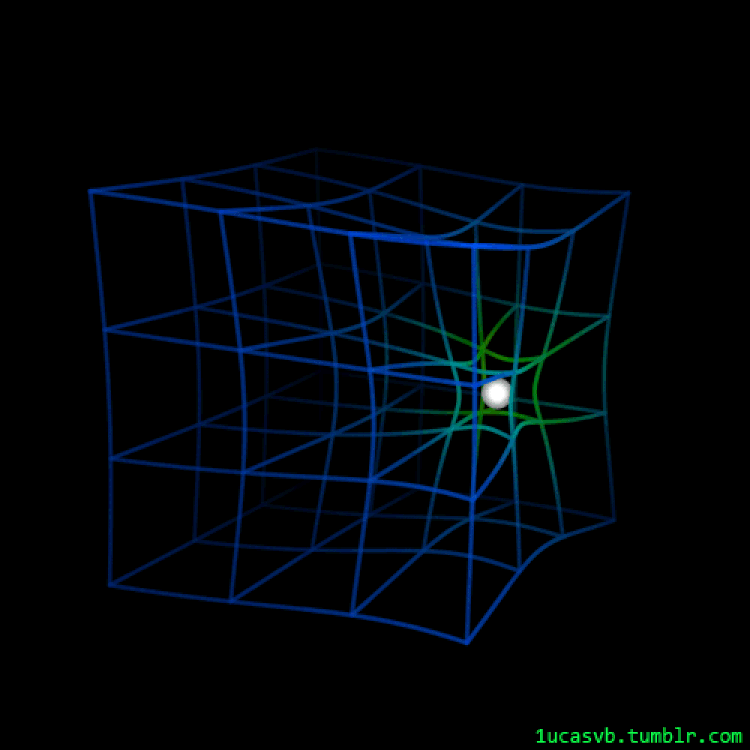
Electromagnetism is a little more complicated. Instead of one type of fundamental charge, there are two: positive and negative electric charges. When like charges (positive and positive or negative and negative) interact, they repel, while when opposite charges (positive and negative) interact, they attract.
This offers an exciting possibility that gravity doesn’t: the ability to have a bound state that doesn’t exert a net force on an external, separately-charged object. When equal amounts of positive and negative charges bind together into a single system, you get a neutral object: one with no net charge to it. Free charges exert attractive and/or repulsive forces, but uncharged systems do not. That’s the biggest difference between gravitation and electromagnetism: the ability to have neutral systems composed of non-zero electric charges.
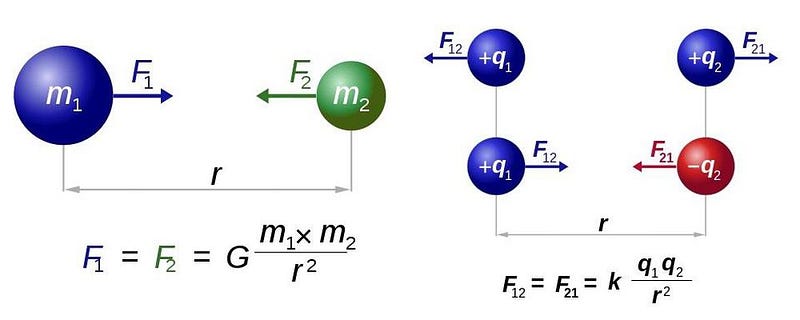
If we were to envision these two forces side-by-side, you might think of electromagnetism as having two directions, while gravitation only has a single direction. Electric charges can be positive or negative, and the various combinations of positive-positive, positive-negative, negative-positive, and negative-negative allow for both attraction and repulsion. Gravitation, on the other hand, only has one type of charge, and therefore only one type of force: attraction.
Even though there are two types of electric charge, it only takes one particle to take care of the attractive and repulsive action of electromagnetism: the photon. The electromagnetic force has a relatively simple structure — two charges, where like ones repel and opposites attract — and a single particle, the photon, can account for both electric and magnetic effects. In theory, a single particle, the graviton, could do the same thing for gravitation.
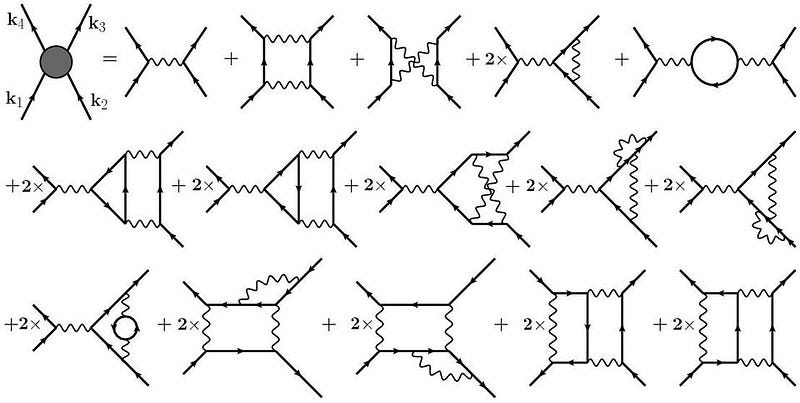
But then, on an entirely different footing, there’s the strong force. It’s similar to both gravity and electromagnetism, in the sense that there is a new type of charge and new possibilities for a force associated with it.
If you think about an atomic nucleus, you must immediately recognize that there must be an additional force that’s stronger than the electric force is, otherwise the nucleus, made of protons and neutrons, would fly apart due to electric repulsion. The creatively-named strong nuclear force is the responsible party, as the constituents of protons and neutrons, quarks, have both electric charges and a new type of charge: color charge.
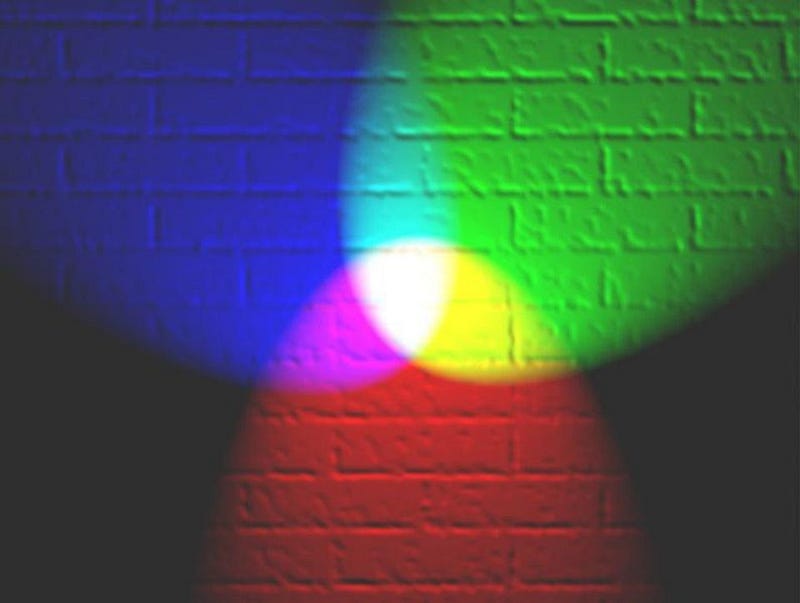
Contrary to what you might expect, though, there’s no color involved at all. The reason we call it color charge is because instead of one fundamental, attractive type of charge (like gravity), or two opposite types of fundamental charge (positive and negative, like electromagnetism), the strong force is governed by three fundamental types of charge, and they obey very different rules than the other, more familiar forces.
For electric charges, a positive charge can be cancelled out by an equal and opposite charge — a negative charge — of the same magnitude. But for color charges, you have three fundamental types of charge. In order to cancel out a single color charge of one type, you need one of each of the second and third types. The combination of equal numbers of all three types results in a combination that we call “colorless,” and colorless is the only combination of composite particle that’s stable.
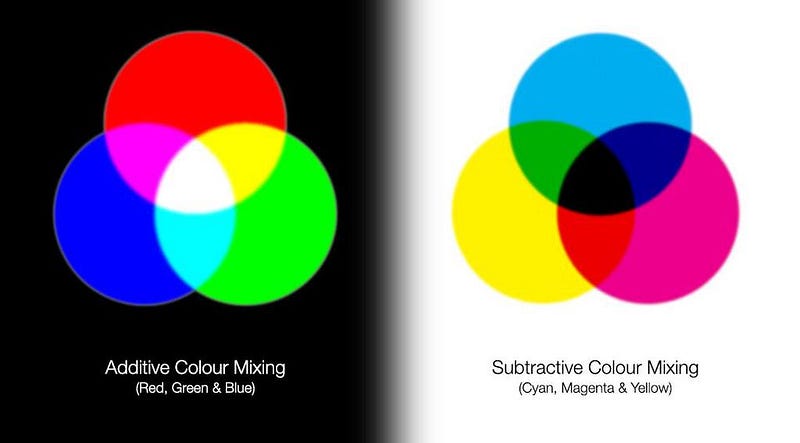
This works independently for quarks, which have a positive color charge, and antiquarks, which have a negative color charge. If you picture a color wheel, you might put red, green and blue at three equidistant locations, like an equilateral triangle. But between red and green would be yellow; between green and blue would be cyan; between red and blue would be magenta.
These in-between color charges correspond to the colors of the antiparticles: the anticolors. Cyan is the same as anti-red; magenta is the same as anti-green; yellow is the same as anti-blue. Just as you could add up three quarks with red, green and blue colors to make a colorless combination (like a proton), you could add up three antiquarks with cyan, magenta and yellow colors to make a colorless combination (like an antiproton).
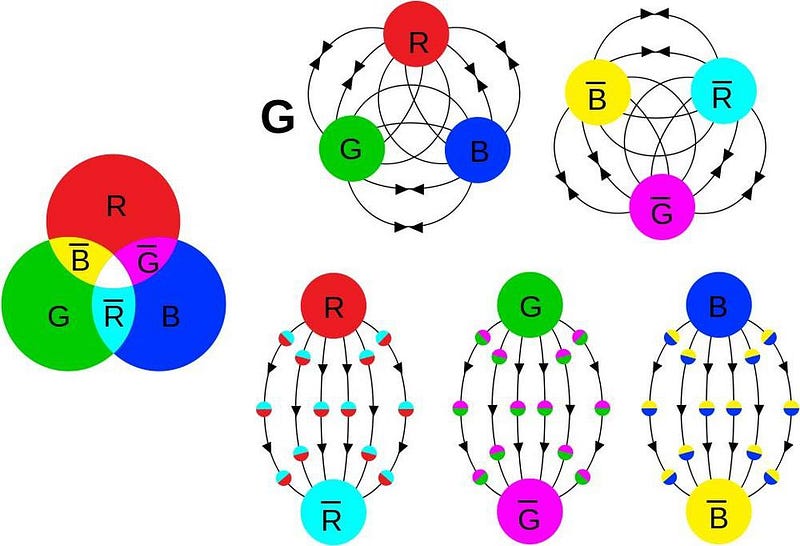
If you know anything about color, you might start thinking of other ways to generate a colorless combination. If three different colors or three different anticolors could work, maybe the right color-anticolor combination could get you there?
In fact, it can. You could mix together the right combination of a quark and an antiquark to produce a colorless composite particle, known as a meson. This works, because:
- red and cyan,
- green and magenta,
- and blue and yellow
are all colorless combinations. So long as you add up to a colorless net charge, the rules of the strong force permit you to exist.
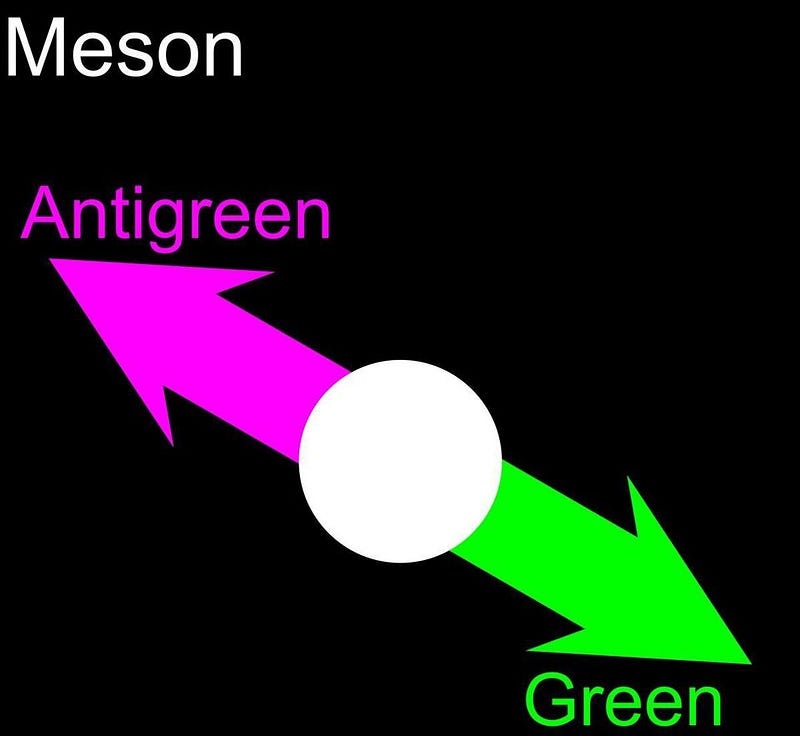
This might start your mind down some interesting paths. If red + green + blue is a colorless combination, but red + cyan is colorless too, does that mean that green + blue is the same as cyan?
That’s absolutely right. It means that you can have a single (colored) quark paired with any of the following:
- two additional quarks,
- one antiquark,
- three additional quarks and one antiquark,
- one additional quark and two antiquarks,
- five additional quarks,
or any other combination that leads to a colorless total. When you hear about exotic particles like tetraquarks (two quarks and two antiquarks) or pentaquarks (four quarks and one antiquark), know that they obey these rules.

But color is only an analogy, and that analogy will actually break down pretty quickly if you start looking at it in too much detail. For example, the way the strong force works is by exchanging gluons, which carry a color-anticolor combination with them. If you are a blue quark and you emit a gluon, you might transform into a red quark, which means the gluon you emitted contained a cyan (anti-red) and a blue color charge, enabling you to conserve color.
You might think, then, with three colors and three anticolors, that there would be nine possible types of gluon that you could have. After all, if you matched each of red, green and blue with each of cyan, magenta and yellow, there are nine possible combinations. This is a good first guess, and it’s almost right.
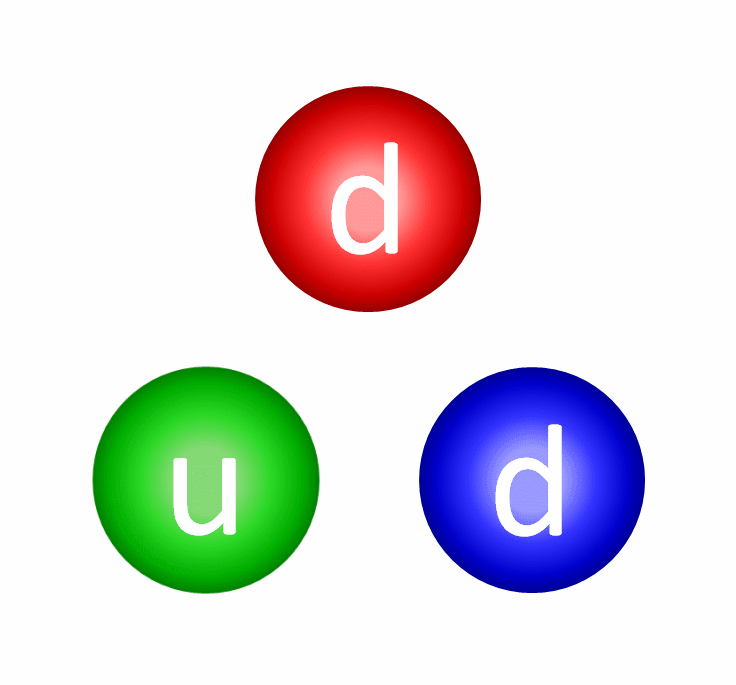
As it turns out, though, there are only eight gluons that exist. Imagine you’re a red quark, and you emit a red/magenta gluon. You’re going to turn the red quark into a green quark, because that’s how you conserve color. That gluon will then find a green quark, where the magenta will annihilate with the green and leave the red color behind. In this fashion, colors get exchanged between interacting colored particles.
This line of thinking is only good for six of the gluons, though:
- red/magenta,
- red/yellow,
- green/cyan,
- green/yellow,
- blue/cyan, and
- blue/magenta.
When you run into the other three possibilities — red/cyan, green/magenta, and blue/yellow — there’s a problem: they’re all colorless.

In physics, whenever you have particles that have the same quantum numbers, they mix together. These three types of gluons, all being colorless, absolutely do mix together. The details of how they mix are quite deep and go beyond the scope of a non-technical article, but you wind up with two combinations that are an unequal mix of the three different colors and anticolors, along with one combination that’s a mix of all the colors/anticolor pairs equally.
That last one is truly colorless, and cannot physically interact with any of the particles or antiparticles with color charges. Therefore, there are only eight physical gluons. The exchanges of gluons between quarks (and/or antiquarks), and of colorless particles between other colorless particles, is literally what binds atomic nuclei together.
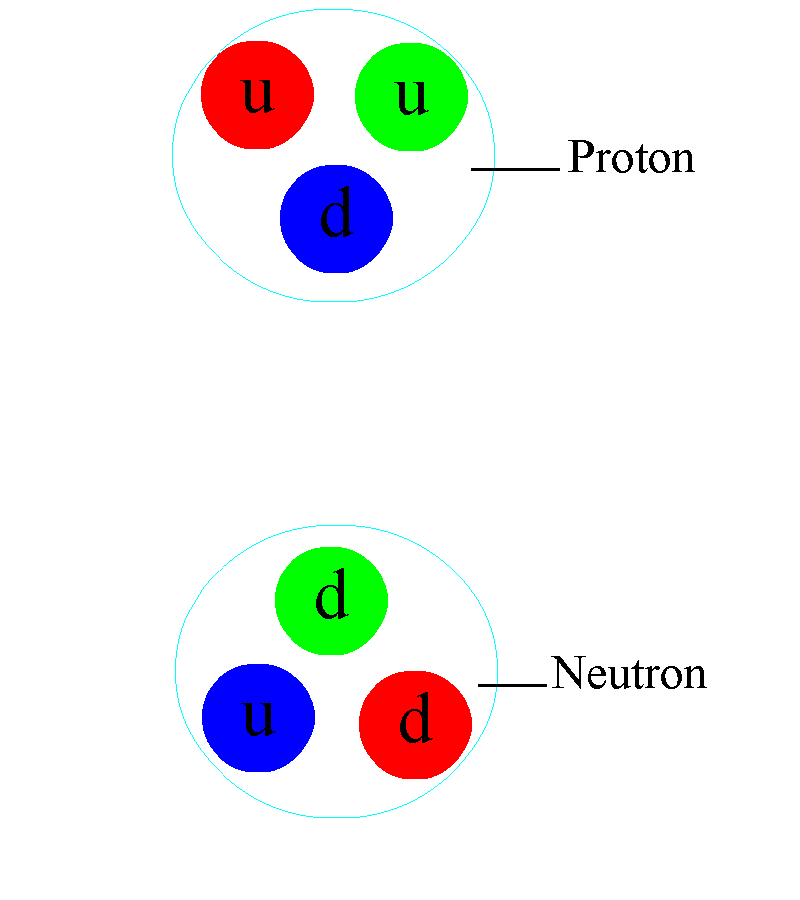
We may call it color charge, but the strong nuclear force obeys rules that are unique among all the phenomena in the Universe. While we ascribe colors to quarks, anticolors to antiquarks, and color-anticolor combinations to gluons, it’s only a limited analogy. In truth, none of the particles or antiparticles have a color at all, but merely obey the rules of an interaction that has three fundamental types of charge, and only combinations that have no net charge under this system are allowed to exist in nature.
This intricate interaction is the only known force that can overcome the electromagnetic force and keep two particles of like electric charge bound together into a single, stable structure: the atomic nucleus. Quarks don’t actually have colors, but they do have charges as governed by the strong interaction. Only with these unique properties can the building blocks of matter combine to produce the Universe we inhabit today.
Ethan Siegel is the author of Beyond the Galaxy and Treknology. You can pre-order his third book, currently in development: the Encyclopaedia Cosmologica.





